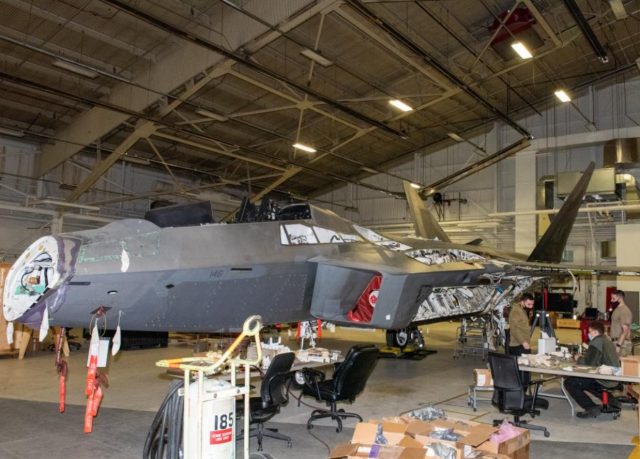
The US Air Force is close to completing repairs on an F-22 Raptor that skidded to a stop on its belly immediately after takeoff at Naval Air Station Fallon, Nevada, in April 2018.
The successful restoration effort is thanks to the aircraft crew chiefs from Joint Base Elmendorf-Richardson, who became part of a unique team tasked with rebuilding the Raptor.
US Air Force Tech. Sgt. Kevin Fitch and Staff Sgt. Ethan Rentz, 3rd Aircraft Maintenance Unit F-22 crew chiefs, are now nearing the end of a years-long process that began shortly after tail number AF-07-146 crashed.
Fortunately, the pilot was unharmed even though the aircraft sustained substantial damage. Since the aircraft belongs to the 3rd Wing, a team from JBER went down to dismantle the jet, load it into a cargo aircraft and transport it home.
Rentz was among the group that disassembled the F-22 in Nevada and prepared it for transport.
“We had to fit it into a C-5 [Galaxy aircraft], so we took off everything that was damaged and everything that wouldn’t fit dimensionally,” Rentz said. “We removed the wings and vertical stabilizers, and the whole belly of the F-22 because those panels were damaged and burnt. We couldn’t have those panels flapping around or breaking off during transit.”
The disassembly took about a month. Then the jet was transported to JBER for a thorough analysis to evaluate whether or not the aircraft should be restored.
“Everything worked out in the simulations, so the aircraft was put in our hangar in January 2020 and put on stands,” Fitch said. “That’s when the complete strip started — the wire harnesses, the struts and the bulkhead. It was down to the bones of the fuselage at that point.
“Contractors, engineers and structures personnel spent about 16 months replacing almost the whole bottom of the aircraft, the fuselage stations and more than 40 wire harnesses,” Fitch continued. “Our active-duty guys didn’t start having a hand in the rebuild until June this year.”

Fitch created inventory lists and order-tracking spreadsheets to keep the myriad of parts needed for the aircraft rebuild organized.
“Sergeant Fitch picked this up from nothing,” Rentz said. “He’s operating at a master or senior master sergeant level because he’s not just handling crew chief tasks, he’s coordinating with multiple different backshops and agencies. He’s essentially running a one-man aircraft squadron.”
As the ordered parts arrive, Rentz and Fitch sort, continue to label and organize them to ensure the rebuild goes smoothly.
“Right now the biggest challenge is acquiring parts because the F-22 isn’t manufactured anymore,” Fitch said. “Some of the parts won’t be available until summer or fall of 2022, so we’ll probably end up canning those from aircraft that are going to be down for a while.”
Canning, short for cannibalizing, is a term that refers to taking usable parts from one aircraft for use on another, depending on various aircraft’s state of repair and the timeline for new manufactured parts to be completed. This method returns aircraft to combat-capable status sooner because it cuts down on time waiting for new parts to be manufactured.
With parts arriving throughout the year, Rentz compared rebuilding the F-22 to completing a puzzle. Though they have some parts to complete sections of the aircraft, the intent is not to undo those repairs when other parts arrive to complete repairs that are necessary behind the previously built section.
With steady progress being made on the rebuild, the functional check flight for tail number AF-07-146 is now projected for March 2022. If the timeline doesn’t get delayed, both Rentz and Fitch will be here to see the jet fly once again.
“Sergeant Fitch and Sergeant Rentz were obvious choices for our F-22 subject matter experts to lead the team with Lockheed Martin and engineers on the rebuild of the crashed aircraft,” said US Air Force Master Sgt. Steven Banda, a 90th Aircraft Maintenance Unit section chief. “Both are skilled maintainers with the technical knowledge to get that aircraft back in the fight. They’ve performed one-of-a-kind modifications and atypical maintenance tasks.”
Since F-22s are no longer manufactured, returning this jet to mission-capable and combat-ready status is important for not only 3rd Wing capabilities, but capabilities of the entire US Air Force.
“It’s really important we get this jet back in flight,” Fitch said. “Five months ago it had no struts, no wings, no flight controls, no hydraulics, no stabilizers. Seeing the progress and doing something out of the ordinary has been really rewarding.”
After being part of the team that disassembled the crashed aircraft and now part of the rebuild team, Rentz has seen and done what only a handful of crew chiefs get to do.
“It’s going to be very satisfying when it flies,” he said. “Several agencies with all their efforts are fulfilling the Air Force’s vision of getting this jet back up.”


























